Physical Address
304 North Cardinal St.
Dorchester Center, MA 02124
Physical Address
304 North Cardinal St.
Dorchester Center, MA 02124
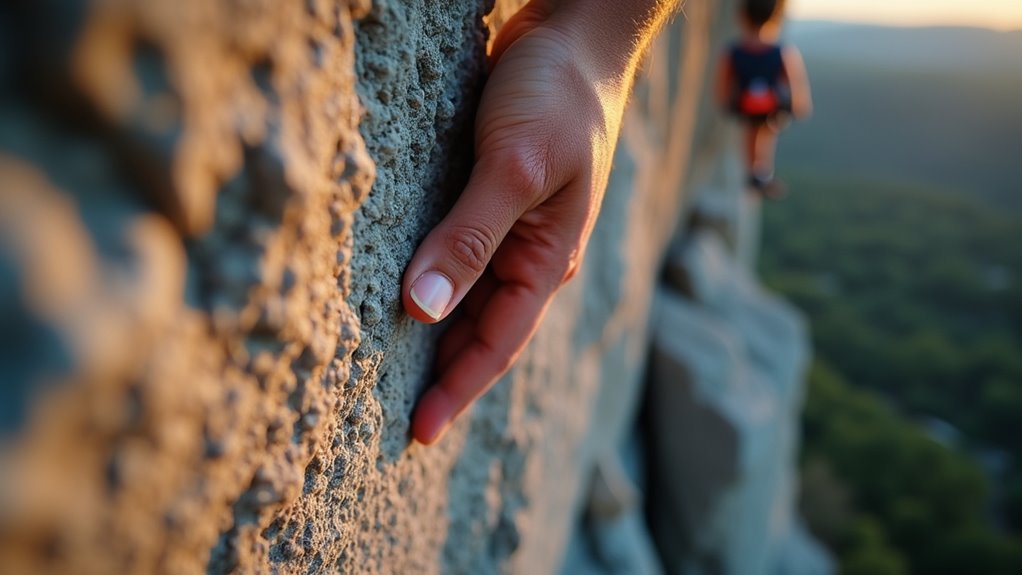
Learn these 12 proven injury prevention strategies that could save your climbing season before your next grip fails unexpectedly.
You’re halfway up a challenging route when your forearm starts cramping, forcing you to take an unexpected fall that could’ve been avoided. This scenario plays out countless times in climbing gyms and on outdoor walls, yet most injuries stem from preventable mistakes rather than unavoidable accidents. Whether you’re a weekend warrior or seasoned climber, understanding the right safety practices can mean the difference between a successful session and weeks of recovery time.
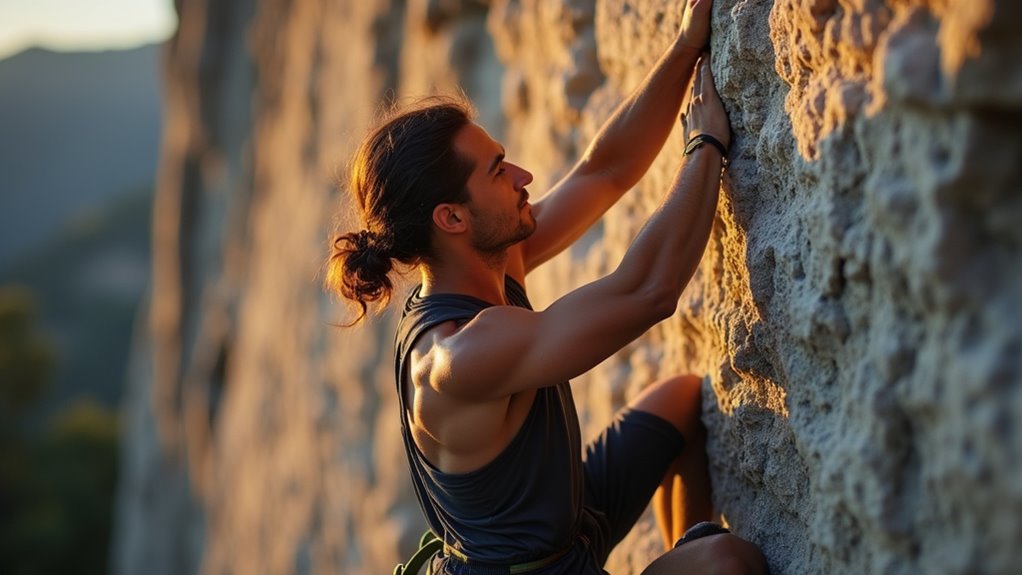
While many climbers rush straight to the wall in their enthusiasm to start climbing, you’re setting yourself up for injury if you skip proper preparation. Your muscles, tendons, and joints need time to adapt before handling climbing’s demands.
Start with five minutes of light cardio to increase blood flow. Follow with dynamic stretches targeting your shoulders, wrists, and hips. Perform arm circles, leg swings, and gentle torso twists. Don’t forget finger flexor stretches and shoulder blade squeezes.
Five minutes of light cardio plus dynamic stretches for shoulders, wrists, and hips prepares your body for climbing’s physical demands.
After climbing, cool down with static stretches held for 30 seconds each. Focus on your forearms, shoulders, and hip flexors. This helps prevent muscle tightness and reduces soreness.
Consistency matters more than perfection—even a brief warm-up beats none at all. Whether you’re pursuing mountaineering as a hobby or developing it into a professional career, these preparation fundamentals remain essential for safe progression.
Because finger injuries rank among the most common and debilitating climbing setbacks, you’ll want to prioritize gradual strength development over quick gains. Your tendons and ligaments adapt much slower than muscles, so rushing the process leads to painful pulley strains and tendonitis.
Start with easier holds and shorter sessions, then progressively increase difficulty over weeks and months. Focus on proper form rather than maximum effort – crimping with poor technique damages your fingers faster than any training benefit you’ll gain.
Incorporate finger-specific exercises like hangboard training, but limit sessions to 2-3 times weekly with rest days between. Listen to your body’s signals; persistent soreness means you’re pushing too hard. Even experienced climbers can fall into the trap of overtraining their grip strength, leading to the same common mistakes that plague beginners.
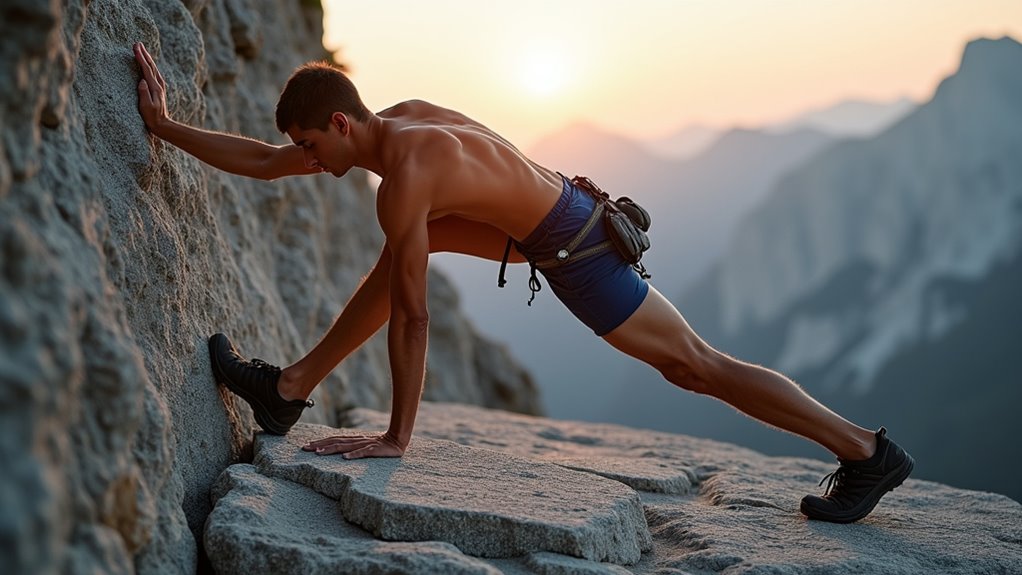
Although most climbers obsess over upper body strength, your core serves as the foundation that connects every movement on the wall. A weak core forces your arms to compensate, leading to overuse injuries and poor climbing efficiency.
Incorporate planks, side planks, and dead bugs into your routine three times weekly. These exercises build the stability you need for dynamic moves and overhangs.
Don’t neglect balance training either—practice single-leg stands with eyes closed or use a balance board while watching TV.
Your core isn’t just about having visible abs; it’s about creating a stable platform that transfers power efficiently between your upper and lower body. Strong core stability reduces strain on your shoulders, elbows, and fingers while improving your overall climbing performance and injury prevention.
Just as expecting mothers need to focus on core strength for outdoor activities like camping, climbers of all stages benefit from prioritizing foundational stability over flashy upper body development.
Poor technique causes more climbing injuries than any other single factor, yet many climbers rush straight to harder routes without mastering the fundamentals. You’ll prevent countless injuries by focusing on proper body positioning and movement patterns before attempting challenging climbs.
Practice keeping your arms straight while climbing to avoid overusing your biceps and shoulders. Use your legs to push upward rather than pulling with your arms. Keep your hips close to the wall and shift your weight efficiently between holds.
Master basic footwork by placing your feet precisely on holds and trusting them completely. Learn to flag, backstep, and mantleshelf properly.
Consider hiring a qualified instructor or joining technique-focused climbing classes. Film yourself climbing to identify bad habits, and practice these movements repeatedly on easier routes until they become automatic.
Once you’ve developed solid technical skills, you can confidently tackle some of the world’s most incredible destinations that offer exceptional climbing opportunities alongside stunning hiking trails.
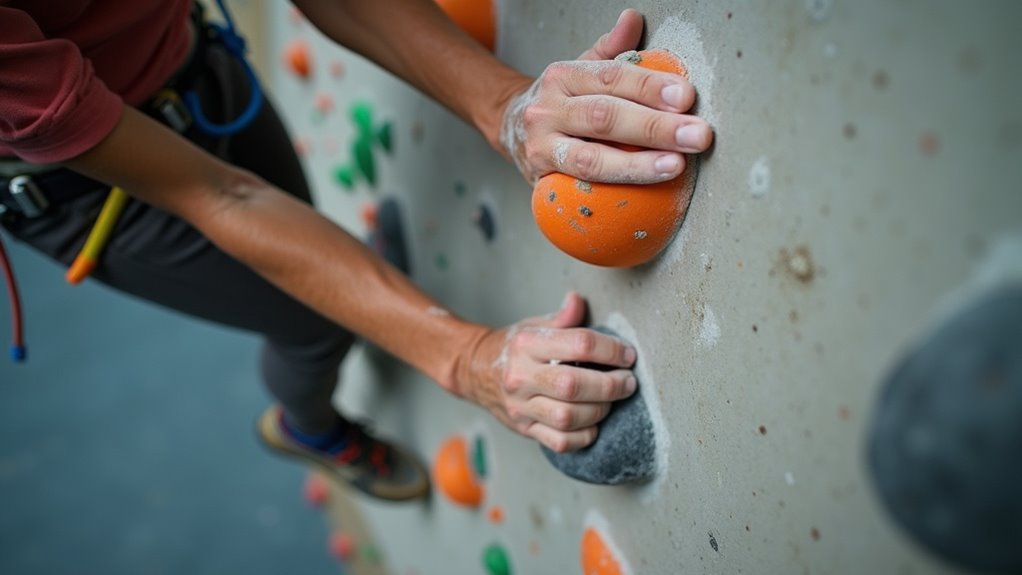
While ego might tempt you to jump on that impressive-looking route, climbing within your current ability prevents the majority of serious injuries. You’ll avoid dangerous falls when you’re not desperately lunging for holds beyond your reach or muscling through moves you haven’t mastered yet.
Start each session with easier routes to warm up properly, then gradually progress to your limit. If you’re consistently failing on a grade, you’re not ready for harder climbs. Listen to your body – fatigue leads to sloppy technique and poor decisions.
When you’re pushing your limits, choose routes with good protection and safe landing zones. Save the scary, runout climbs for when you’re climbing well below your maximum grade. Smart route selection keeps you climbing longer.
Just like scuba divers need essential preparation before exploring challenging depths, climbers should thoroughly prepare before attempting routes at their limit.
Since your life depends on your gear, checking it regularly isn’t optional – it’s essential. Inspect your harness for frayed webbing, worn stitching, and damaged buckles before every climb.
Check your rope for cuts, core shots, and excessive wear, especially at high-friction points. Replace it if you notice any damage or after significant falls.
Examine carabiners for gate function, cracks, and sharp edges that could cut your rope. Test that gates snap shut completely and lock mechanisms work smoothly.
Your helmet should be crack-free with functioning straps and adjusters. Replace it after any significant impact.
Store gear properly – keep ropes out of direct sunlight, avoid extreme temperatures, and maintain a gear log tracking usage and inspection dates.
Quality gear maintenance prevents equipment failures that cause serious injuries. Consider searching for discount camping gear online to find affordable replacement equipment when your current gear reaches the end of its safe lifespan.

Beyond equipment safety, your body’s muscular balance plays a major role in preventing climbing injuries. Climbing heavily develops your pulling muscles—lats, biceps, and forearms—while neglecting pushing muscles like chest, triceps, and shoulders. This imbalance creates injury risks including shoulder impingement and elbow tendonitis.
Climbing’s overdevelopment of pulling muscles while neglecting pushing muscles creates dangerous imbalances that lead to shoulder impingement and elbow tendonitis.
You’ll want to incorporate push-ups, dips, and overhead pressing movements into your routine. Don’t forget your finger extensors either; they’re vital for preventing climber’s elbow. Use rubber bands or specialized tools to strengthen the muscles that open your hands, counteracting all that gripping.
Focus on posterior deltoids and external rotators through band pull-aparts and face pulls. These exercises combat the forward shoulder posture that climbing promotes.
Aim for a 2:1 ratio of pulling to pushing exercises to maintain healthy muscle balance. When you’re ready to apply these strengthening principles in a natural outdoor setting, consider camping in Minnesota where you can find excellent rock formations and climbing opportunities.
Although climbing culture often glorifies pushing through discomfort, your body sends clear signals when something’s wrong—and ignoring them leads to serious injuries.
Sharp, shooting pains differ from normal muscle fatigue. If you feel sudden jolts in your fingers, elbows, or shoulders, stop immediately. Persistent aches that worsen during sessions indicate developing problems, not weakness.
Watch for swelling, especially around joints and tendons. Your skin shouldn’t feel hot or look puffy after climbing.
Stiffness that lasts beyond your usual recovery time signals overuse.
Don’t climb through pain—you’ll transform minor issues into major injuries requiring months of rehabilitation. Take rest days when your body demands them.
Smart climbers distinguish between pushing limits and ignoring warnings. Your long-term climbing career depends on respecting these signals.
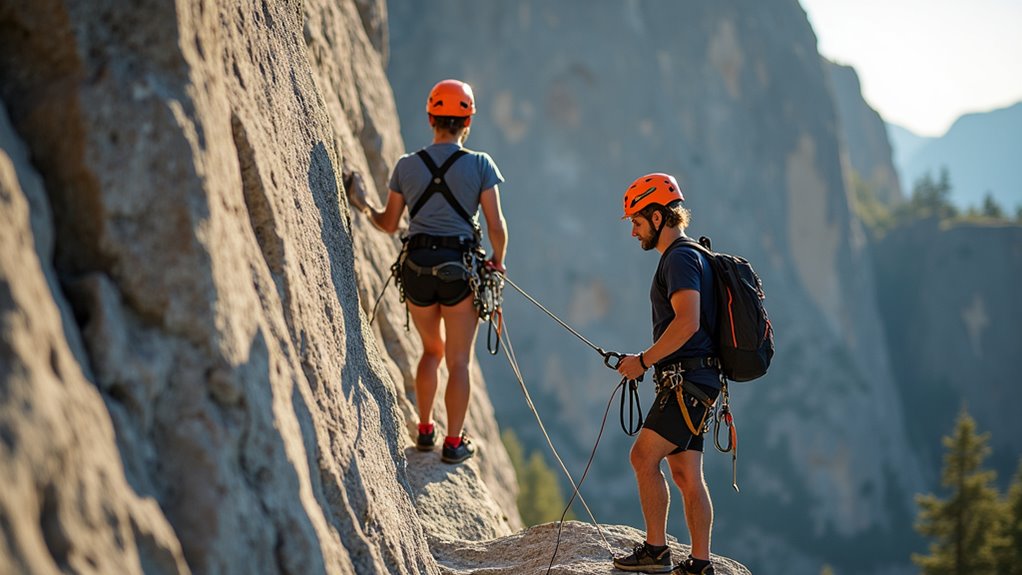
While technique and strength training get most of the attention, mastering safety protocols prevents the majority of serious climbing accidents. You’ll avoid catastrophic falls by double-checking your belay device setup every single time. Always perform a partner check before starting any climb – verify harness buckles, knots, and equipment connections.
Keep your brake hand on the rope at all times when belaying. Never let go, even during casual conversation. Position yourself properly to avoid being pulled into the wall during a fall.
Learn to give dynamic belays that absorb impact rather than creating jarring stops.
Practice emergency scenarios like lowering an unconscious climber or escaping the belay system. These skills become vital when things go wrong and adrenaline takes over.
Just like outdoor enthusiasts who master hammock camping techniques for wilderness adventures, climbers must develop comprehensive safety skills that become second nature in challenging environments.
Safety protocols protect you from acute injuries, but overuse injuries develop more subtly through repetitive stress on the same muscle groups and joints. Climbing repeatedly stresses your fingers, forearms, and shoulders, creating muscle imbalances that lead to tendinitis and other chronic issues.
Cross-training breaks this cycle by strengthening opposing muscle groups and varying your movement patterns. Focus on exercises that work your legs, core, and back extensors. Swimming develops shoulder stability while reducing joint impact. Yoga improves flexibility and addresses the hunched posture climbing creates. Running or cycling builds cardiovascular fitness without taxing your upper body.
You don’t need elaborate routines—two cross-training sessions weekly make a significant difference. This variety keeps your body balanced and resilient, preventing the repetitive strain that sidelines many climbers. Effective injury prevention requires incorporating these diverse training methods into your regular climbing schedule.
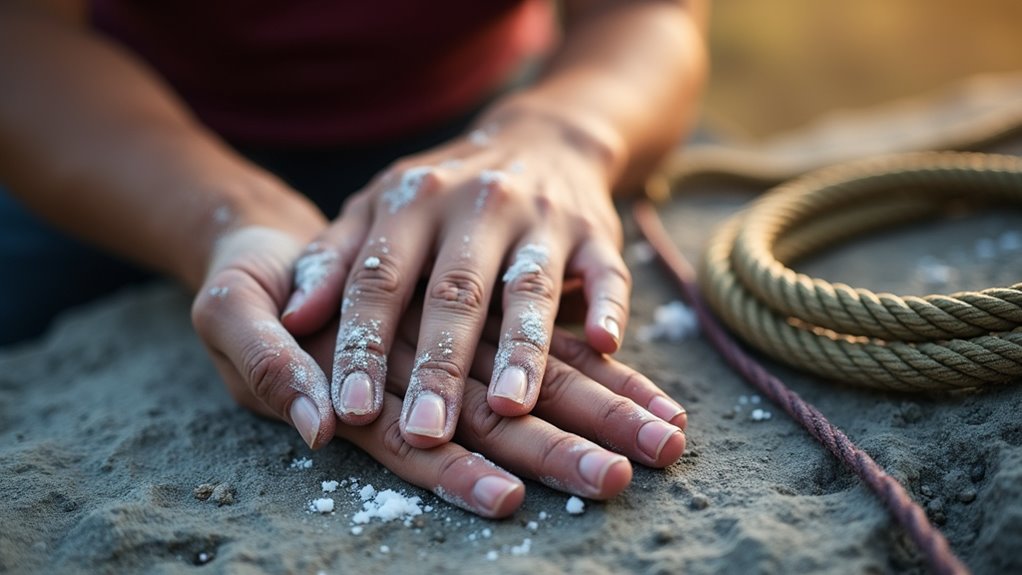
Your muscles need time to repair and strengthen between climbing sessions, yet many climbers push through fatigue and minor aches, thinking they’re building resilience. This mindset actually increases injury risk and hinders progress.
Rest isn’t laziness—it’s when your body adapts and grows stronger. Without adequate recovery, you’ll accumulate micro-damage that leads to overuse injuries like tendonitis or pulley strains.
Follow these recovery guidelines:
Quality rest prevents setbacks that could sideline you for weeks or months. Consider using a hammock camping setup for your recovery days outdoors, as it provides excellent relaxation while keeping you connected to nature. Your future climbing self will thank you.
Even seasoned athletes benefit from coaching, and climbing’s no exception. Working with experienced climbers and instructors dramatically reduces your injury risk by teaching you proper technique from the start. Bad habits are harder to break than learning correctly initially.
Proper technique from day one prevents injuries and eliminates bad habits that become harder to correct later.
Experienced mentors spot dangerous movements you might miss, like overgripping or poor body positioning that strains joints. They’ll teach you efficient climbing techniques that conserve energy and reduce strain on your muscles and tendons.
Don’t skip professional instruction, especially for technical skills like belaying, rappelling, and anchor building. These aren’t areas where you want to learn through trial and error. Qualified instructors ensure you’re using gear correctly and following safety protocols.
Even if you’ve been climbing for years, occasional sessions with experienced climbers can refine your technique and prevent injury-causing habits. Expert guidance on climbing footwork techniques is particularly valuable, as proper foot placement and movement patterns are fundamental to safe, efficient climbing and injury prevention.
You’ve built your climbing foundation like constructing a fortress—each technique a stone, every rest day mortar binding your progress. Your fingers are tools that need sharpening, your body a machine requiring fuel and maintenance. Don’t let enthusiasm become your enemy or pride your downfall. Listen to your inner compass when it whispers caution. Climb smart, train consistently, and you’ll find that every summit becomes not just reachable, but safely conquered.